Back when I was a young man, Volkswagen introduced the GTI. Even then it was clear that, for a combination of real-world functionality and driving fun, a good hot hatch was the way to go. Which makes it puzzling that the Koreans, despite their great strides in recent years, have fielded performance-oriented hatches that were rather lukewarm. I really wanted to like the latest Hyundai Elantra GT, but we couldn't quite connect. Part of the problem: the 201-horsepower turbocharged 1.6-liter turbo both Hyundai and Kia have been relying on to power their performance-oriented compacts just doesn't have the torque of the turbocharged 2.0-liter (and larger) engines in truly hot hatches like the GTI.
Hyundai has had a turbocharged 2.0-liter engine in its inventory. Why couldn't they offer it in a compact? Well, now they finally do. Overseas you can buy an Elantra GT (badged as the i30 N) with a 275-horsepower turbocharged 2.0-liter engine. In North America this same engine is now available in the sportier but less functional three-door Veloster N. With 37 more horsepower than the GTI, adapative dampers, and an available limited-slip differential, the Veloster N's specs are promising. Does the sound and feel of the driving experience similarly fulfill expectations?
I wanted to drive a new GTI for comparison purposes, but the local Volkswagen dealer had none with a manual. (You cannot get a two-pedal Veloster N.) So I drove the recently redesigned Jetta GLI instead. After a generation spent on a separate platform, the Jetta GLI is once again closely related to the Golf GTI under its skin, and thus can serve as a stand-in for the latter. Driving the Veloster N and Jetta GLI back-to-back, it became clear how well Hyundai had done in its first serious effort to field a hot hatch.
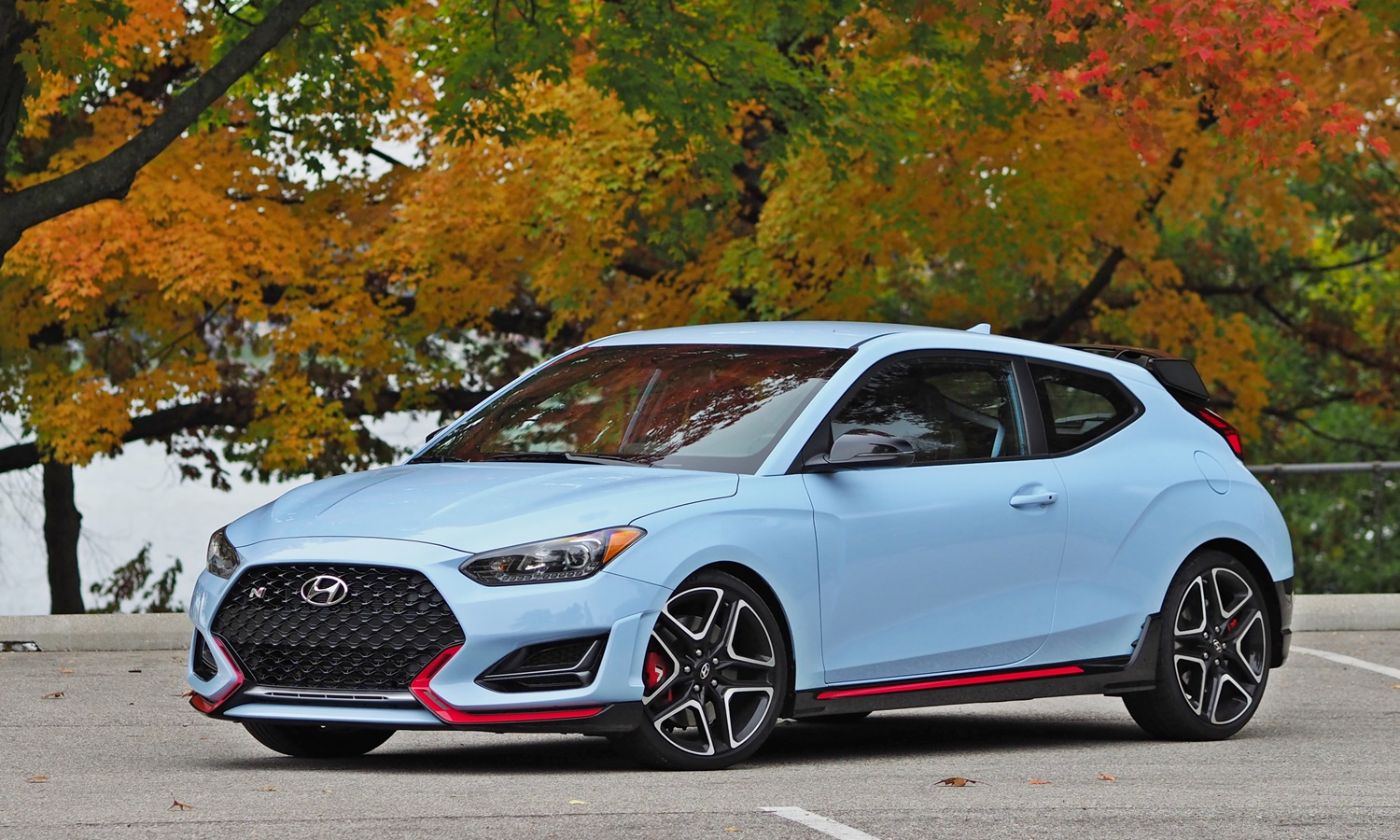
More muscular and chiseled than the original Veloster. This is the single-door driver side. more Veloster photos
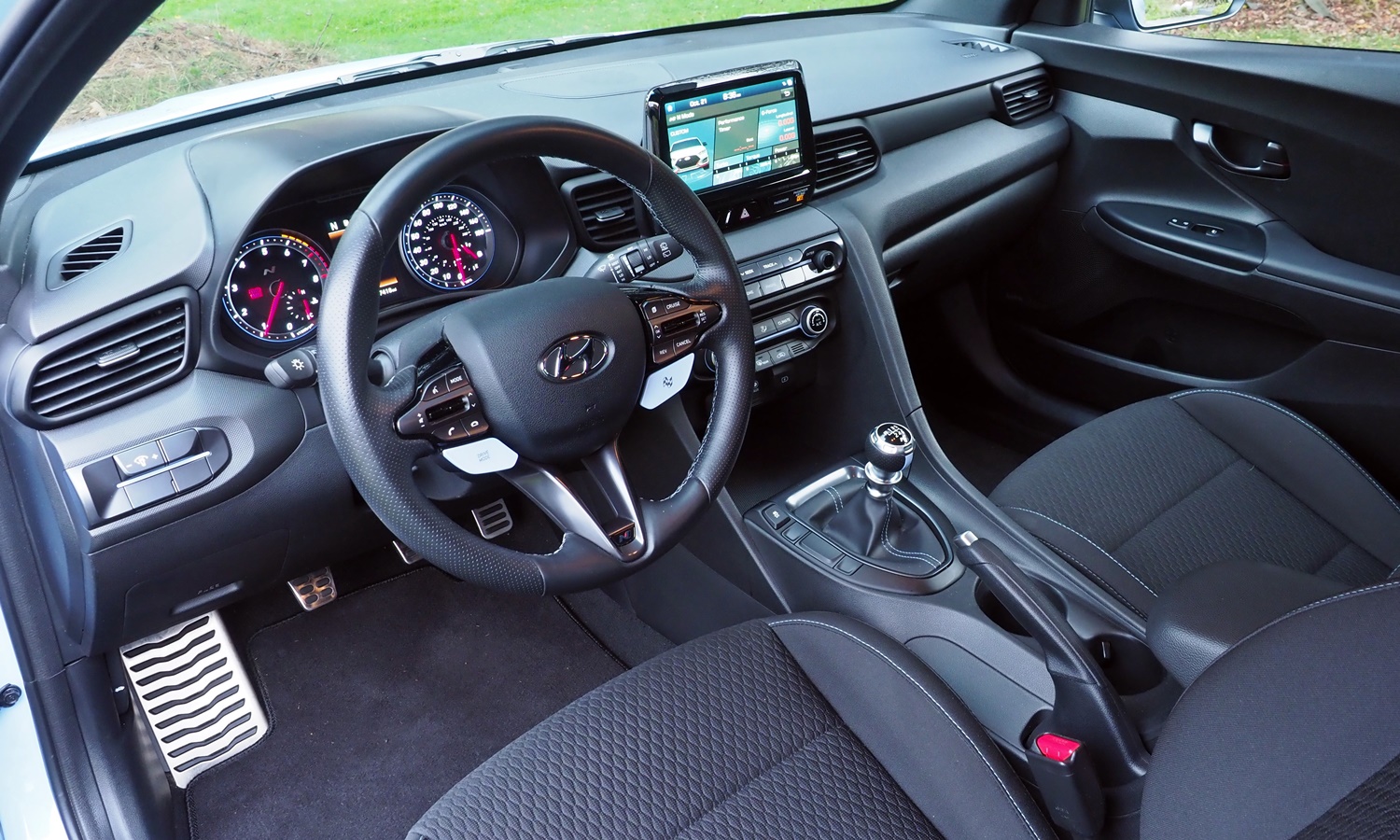
The new Veloster's interior isn't nearly as stylish as its exterior.
| |
Compared to the Jetta |
| Exterior styling |
 Better
Worse
Better
Worse
|
Thanks to its sleek, futuristic styling and asymmetrical design, with one door on the driver side but two on the passenger side, the original, 2012 Hyundai Veloster attracted far more attention than the typical hatchback. It looked like a concept car, especially from the rear, but you could actually buy it--and for not much money.
With familiarity the novelty wears off. And the second-generation Veloster's design is less adventurous than the original's. But the Veloster remains a significantly more stylish car than a more conventional, boxier hatchback like the Volkswagen GTI or Hyundai's own Elantra GT. It had better be, or why make the sacrifice in functionality?
The Veloster is also far more tastefully styled than the Honda Civic Type-R. It has the de rigeur spoiler, splitters, side skirts, and faux diffuser, with those along the bottom highlighted in red, yet this isn't a car that looks ridiculous on someone over the age of 25.
The Veloster N looks most striking--and quite attractive IMHO--in the powder blue of the tested car.
| Handling |
 Better
Worse
Better
Worse
|
In tuning, the Veloster N feels firmer and sharper than the Volkswagen GTI and Jetta GLI, but it's not nearly as hardcore as the hyper-engaging Honda Civic Type-R. For many people the Hyundai could hit the sweet spot, as ultra-quick responses and an ultra-firm suspension render a car much less livable in daily driving.
As it is, the Veloster N is very fun (if not quite thrilling) to drive and highly competent when the road gets curvy. The steering, though not the sharpest, feels moderately quick and accurate. In its "sport" and especially in its "sport+" settings this steering can feel overly heavy in typical driving. I usually set the system to "normal" to enhance perceived agility. (On a track or a high-speed curvy road I'd opt for "sport+.") Even in "normal" the Veloster N's steering feels considerably heavier than the Jetta GLI's (which feels too light for my taste). Yet, despite its lack of heft and looser damping, the Volkswagen's steering and suspension provide clearer and more nuanced feedback. I wish the Hyundai communicated as well.
A highly recommended $2,100 Performance Package adds 25 horsepower (for a total of 275), a multi-mode exhaust, upsized brakes, Pirelli P Zero summer tires on 19-inch wheels (rather than Michelin Pilot Sports on 18s), and an electronically controlled mechanical limited-slip differential (eLSD) to the Veloster N. The last, as in the Volkswagen GTI and Honda Civic Type-R, is all but necessary in a powerful front-wheel-drive car. It helps avert wheelspin (still easily achieved in first gear and initially in second) and (together with brake-based torque vectoring) helps curb understeer and tighten up the car's handling.
Technically, the Veloster N handles very well. Good balance, precise body control, minimal roll, and admirable composure all contribute to a car that's easy to drive quickly. I enjoyed my week with it.
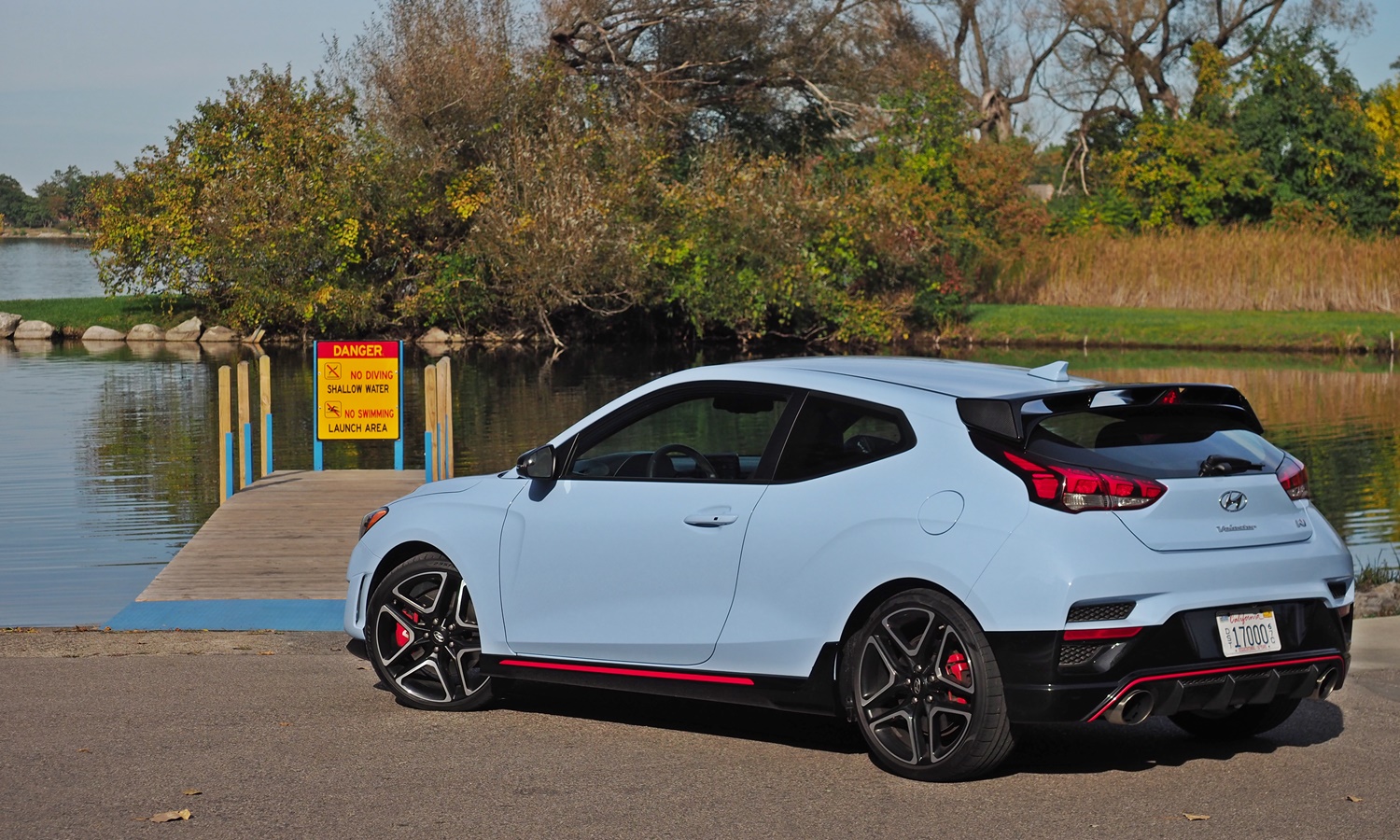
The Veloster's styling remains dramatic, but the drama is now more in the details than the shape.
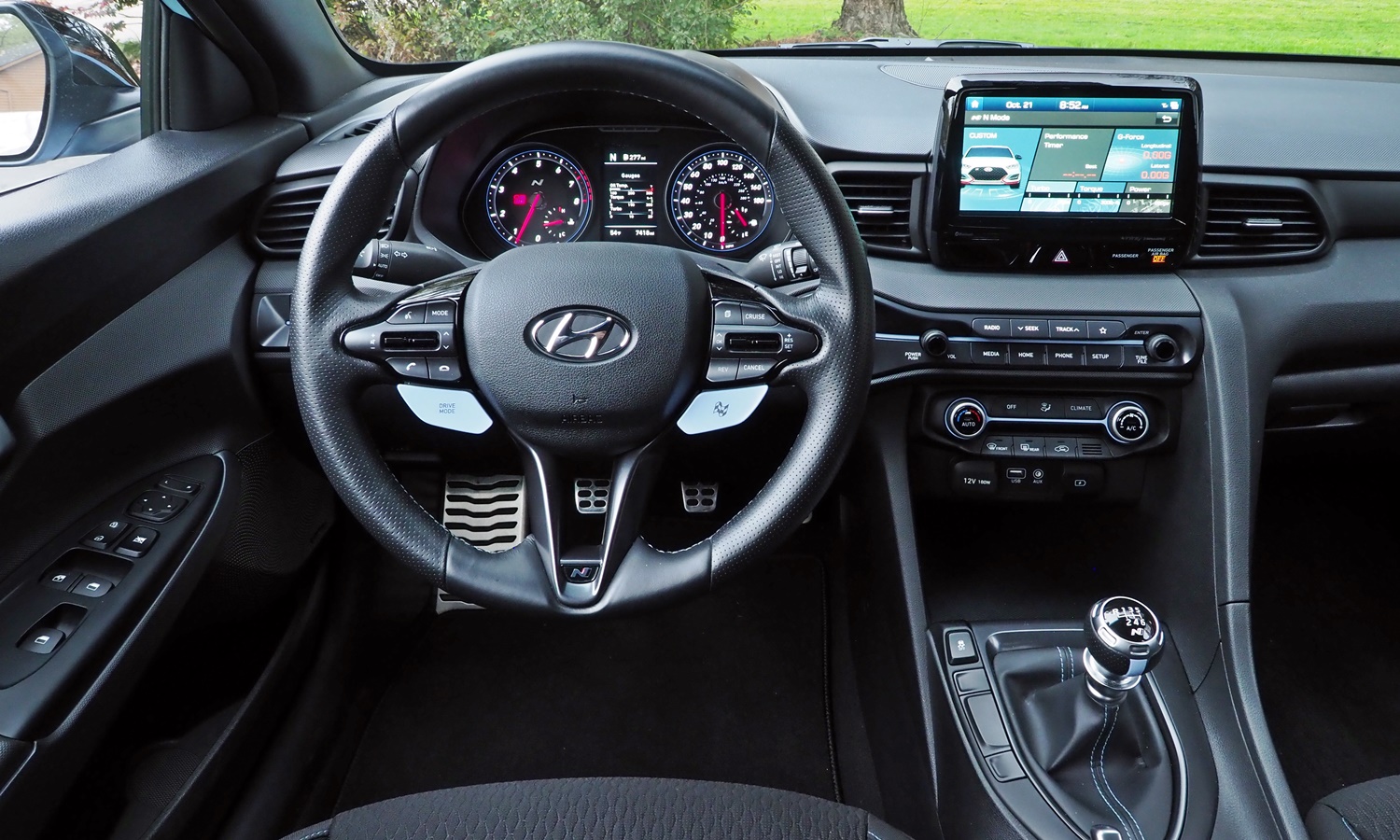
Typical of Hyundai, the controls are well organized and easy to use.
| Powertrain performance |
 Better
Worse
Better
Worse
|
The 275-horsepower Hyundai Veloster N (with Performance Package) has nearly as much power as a front-wheel-drive compact can practically make use of. (I say "nearly" because the Civic Type-R has 306 horsepower.) Even with the eLSD and high-performance summer tires, hard acceleration can yield wheel-hop, wheelspin, and mild torque steer in first gear and the beginning of second.
A conventional all-wheel-drive system, as employed in the 292-horsepower Golf R, would virtually eliminate wheelspin and torque steer, but render the chassis so insensitive to inputs that it would be less fun to drive. A more sophisticated torque vectoring all-wheel-drive system like the ones in the no longer manufactured Ford Focus RS and Mitsubishi Evo would raise the car's limits without dulling its responsiveness, but would be heavy and expensive.
Like that in many current high-performance cars, the Veloster N's exhaust crackles and pops when you lift off the accelerator at high rpm. Too much noise? Then select "normal" mode rather than "sport" or "sport+." Other than this sporty exhaust the engine sounds like nothing special. This shouldn't come as much of a surprise, as this engine wasn't initially developed for use in high-performance compacts. Instead, it was offered in Hyundai's and Kia's midsize sedans and crossovers as a V6 alternative.
German manufacturers sometimes underrate their engines, while the 201-horsepower 1.6-liter turbocharged engine in the regular Veloster feels weaker than its specs suggest it should. Between this and the limitations imposed by front-wheel-drive, I wondered whether the 275-horsepower Veloster N would actually feel more powerful than the 228-horsepower Volkswagen. Well, it does. With its throttle cracked wide open, the Hyundai accelerates with significantly more vigor.
The Veloster N's shifter feels a little clunky--it's no match for tight and precise levers in Hondas and Mazdas. But it feels tighter and generally better than the lighter, longer-throw shifter in the Jetta GLI. Automatic rev-matching simplifies downshifts.
| Controls and instruments |
 Better
Worse
Better
Worse
|
As in other Hyundais, the Veloster's controls are fairly simple and easy to operate. I especially liked being able to toggle among the different driving modes, including a highly configurable custom mode, using steering wheel-mounted paddles.
| Warranty, maintenance cost |
 Better
Worse
Better
Worse
|
Hyundai warranties the Veloster N's high-performance powertrain for ten years / 100,000 miles. For the second owner the powertrain matches the five year / 60,000-mile basic warranty. Still pretty good. Hyundai now also covers the cost of maintenance for the first 3 years / 36,000 miles.
For 2019, Volkswagen covered nearly the entire car for 6 years / 72,000 miles--arguably better than Hyundai. For 2020, though, they've reduced their basic warranty to four years / 50,000 miles. Though this is still better than the more typical three years / 36,000 miles, Hyundai regains a clear advantage.
| |
Compared to the Jetta |
| Feature availability |
 Better
Worse
Better
Worse
|
Unlike the regular Veloster or the Volkswagen GTI, the Veloster N is offered in only a single trim level, and the only option is the Performance Package. If you want an automatic transmission, a sunroof, leather upholstery, a power driver seat, heated seats, or the latest electronic driving aids, you're out of luck. The last are increasingly standard on alternatives. Thankfully a proximity key and a decent audio system are standard--the Veloster N isn't entirely barebones.
Exterior colors are limited to the pictured blue, red, and black. Black cloth with powder blue stitching is mandatory.
| Cargo capacity |
 Better
Worse
Better
Worse
|
With its hatchback, the Hyundai Veloster N is much more versatile than a coupe or sedan. But compared to a Volkswagen GTI or Elantra GT, the cargo compartment is smaller and the rear opening is higher and tighter. I was able to squeeze in my 29er mountain bike, but not easily.
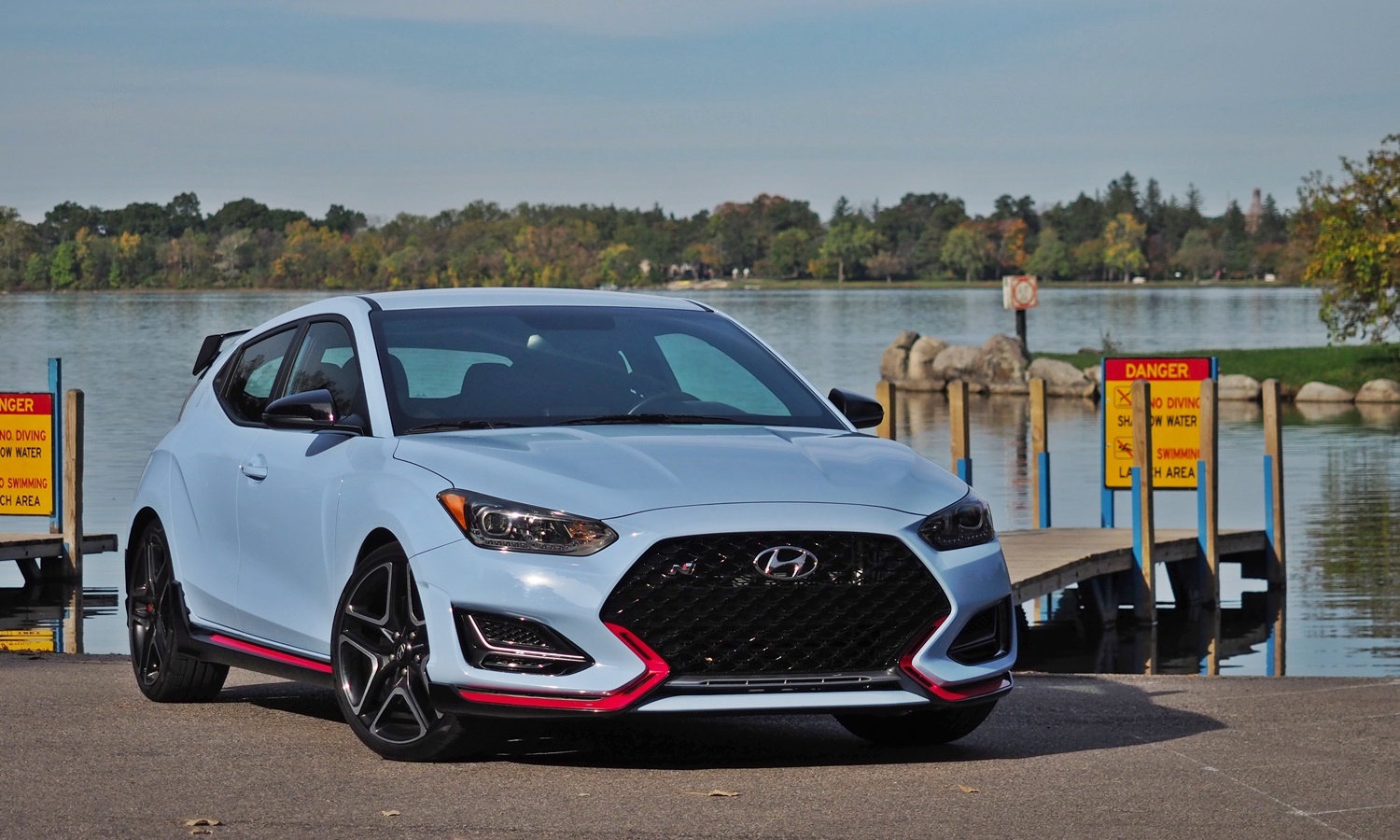
Large grille, of course, but it works with the shape. This is the two-door side of the car.
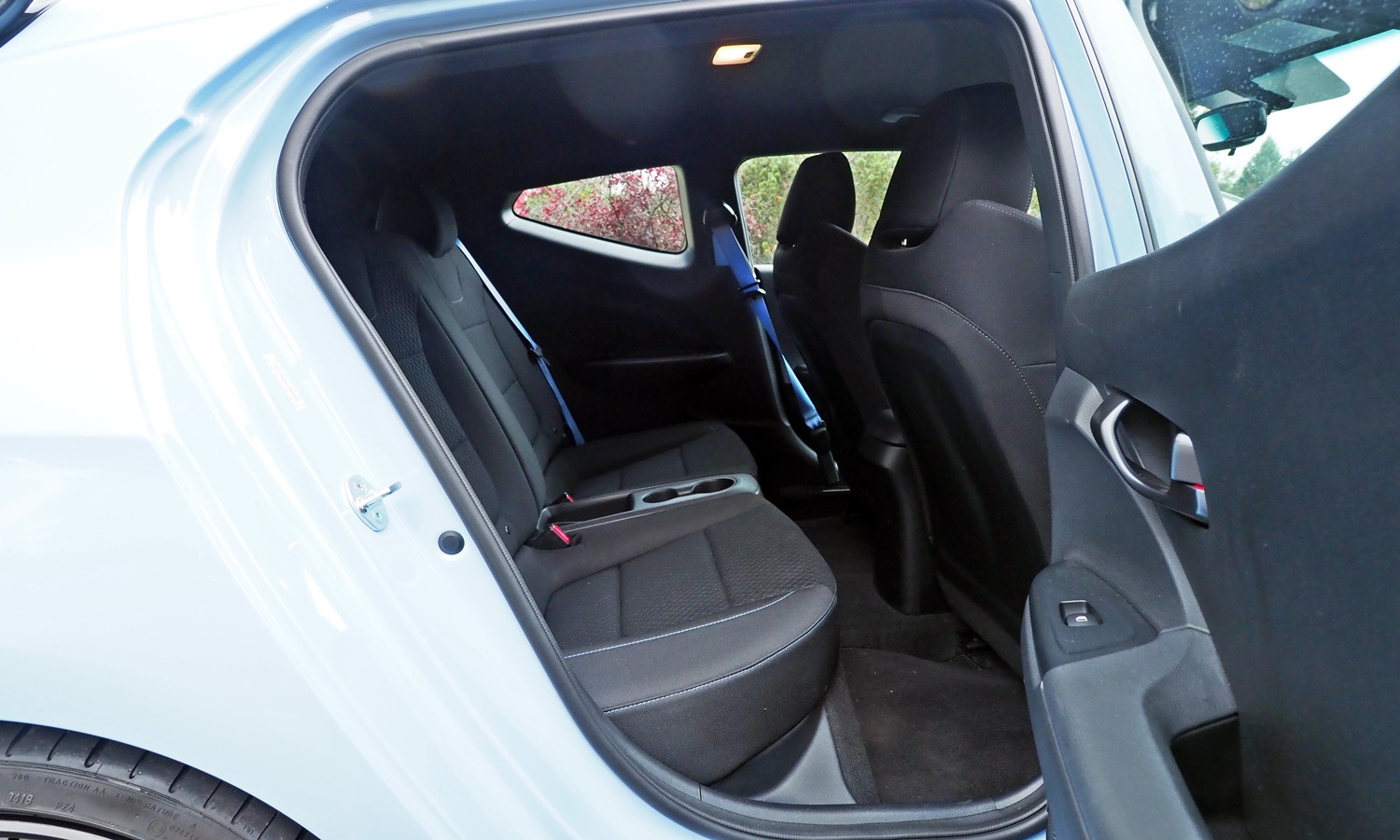
Viable rear seat. The hard part is getting through the door--and there's only one of them.
| Materials & workmanship |
 Better
Worse
Better
Worse
|
You're also out of luck if you want a high-end interior in the Veloster N. Most surfaces are hard plastic. They feel solid enough and don't seem cheap, but make no attempt to appear upscale. That's just not what this car is about.
A Volkswagen GTI's interior looks and feels nicer. A Jetta GLI's interior, on the other hand, looks and feels cheaper than the Hyundai's. It's not hard to figure out why the GLI sedan costs a few thousand less than the GTI hatchback.
| Quietness |
 Better
Worse
Better
Worse
|
Aside from the performance exhaust, the Veloster N is comfortably quiet inside. Unfortunately that exhaust drones a bit at highway speeds even in "normal" mode. I didn't mind it, but you might.
| Ride smoothness |
 Better
Worse
Better
Worse
|
For a car with its handling capability, the Veloster N rides well. But those seeking a cushy ride won't find it here. Some reviewers have complained that the ride is too firm when the standard adaptive dampers are set to "sport," and especially when they're set to "sport+." I didn't detect a dramatic difference between the modes. Even in "normal" the Veloster N's ride sometimes feels jiggly. But even in "sport+" I never thought it felt harsh or unlivable.
The suspension tuning in the GTI and GLI is a little softer. That in the Honda Civic Type-R is much firmer.
| |
Compared to the Jetta |
| Fuel economy |
 Better
Worse
Better
Worse
|
As might be expected with an engine usually employed in pedestrian sedans and crossovers, the Veloster N gets good fuel economy for a high-performance car. In EPA testing it managed 22 mpg in the city cycle and 28 mpg (29 mpg for 2020) in the highway cycle. This ties the Honda Civic Type R. However, the Volkswagen GTI scores significantly better: 24 mpg city, 32 mpg highway.
| Front seat support & comfort |
 Better
Worse
Better
Worse
|
I found the Hyundai Veloster N's driver seat to be both very supportive and comfortable despite the lack of adjustments beyond fore-aft, recline, and height. If I had more "why to buy" slots the front seats would have occupied one of them.
| Driving position & visibility |
 Better
Worse
Better
Worse
|
In the Hyundai Veloster you sit higher than in a sports car but lower than in the typical compact hatchback. In the Jetta GLI I felt like I was sitting much higher, and this contributed to it feeling much less sporty.
Rearward visibility was a major weakness in the original Veloster. It could be impossible to see if cars were approaching from a rear quarter. The second-generation car is better thanks to larger rear windows. (There's a reason concept cars aren't often produced as-is.) But if you really want to see out well, you'll want a more conventional hatchback.
| Rear seat room & comfort |
 Better
Worse
Better
Worse
|
The Hyundai Veloster's rear seat is sufficiently large for a two adults of average height. In a pinch, it'll serve well. More of an issue than room is getting into and out of the seat, as the roof line dips low in the rear and there's only a door on one side.
| Price or payments |
 Better
Worse
Better
Worse
|
For 2020, the Hyundai Veloster N lists for $28,555 without the Performance Package, and for $30,655 with it. A base, 228-horsepower Volkswagen GTI splits the difference at $29,515. But a Jetta GLI begins much lower, at $27,165. Moving in the other direction, a Honda Civic Type-R lists for $27,950. Looking at all-wheel-drive alternatives, a 268-horsepower Subaru WRX (offered only in sedan form) starts at $28,395, the more hardcore 310-horsepower WRX STI runs $37,895, and a 292-horsepower Volkswagen Golf R (with far more luxury features and safety tech than the Hyundai) lists for $41,290. The Subarus could become much more competitive (and possibly be offered in hatchback form again) when they are redesigned for the 2021 model year.
While the Veloster N isn't quite a steal (at least without discounts and incentives), it is the best-performing compact you can buy without spending well over $30,000.
The Veloster N looks good and drives well. I do wish its steering and suspension provided more feedback, and suspect that Hyundai will also get this right with the next iteration. Currently the Volkswagen GTI retains an edge in this area, but otherwise cannot perform or handle as well as the Hyundai.
The Hyundai also worries me less from a reliability perspective, though the company's turbocharged 2.0-liter engine was somewhat prone to failure early in its production run. Hyundai's electrical systems are less complicated, and its warranty is longer.
The practical side of me wishes Hyundai would also offer the Elantra GT in N form here. But the Veloster is considerably more practical than the average sports car, and offers a lot of style, performance, and handling for $30,000. I can personally see myself owning a Veloster N, which isn't something I can say about many cars.
But I can also say the same about the Volkswagen GTI. If I had to decide between them, which would win out? The Volkswagen is more practical and communicates better, while the Veloster N is much more stylish, performs better both in a straight line and in curves, and would concern me less after its longer warranty runs out. It's a very tough call. This is quite an achievement for Hyundai, since this is its first serious attempt at a truly hot hatch while VW has been at it for forty years. My expectations have been exceeded. So have those of other auto writers, judging from the awards the Veloster N has been receiving.
Am I dodging the question? Maybe. I can see myself going either way based on varying priorities. How would you answer it?
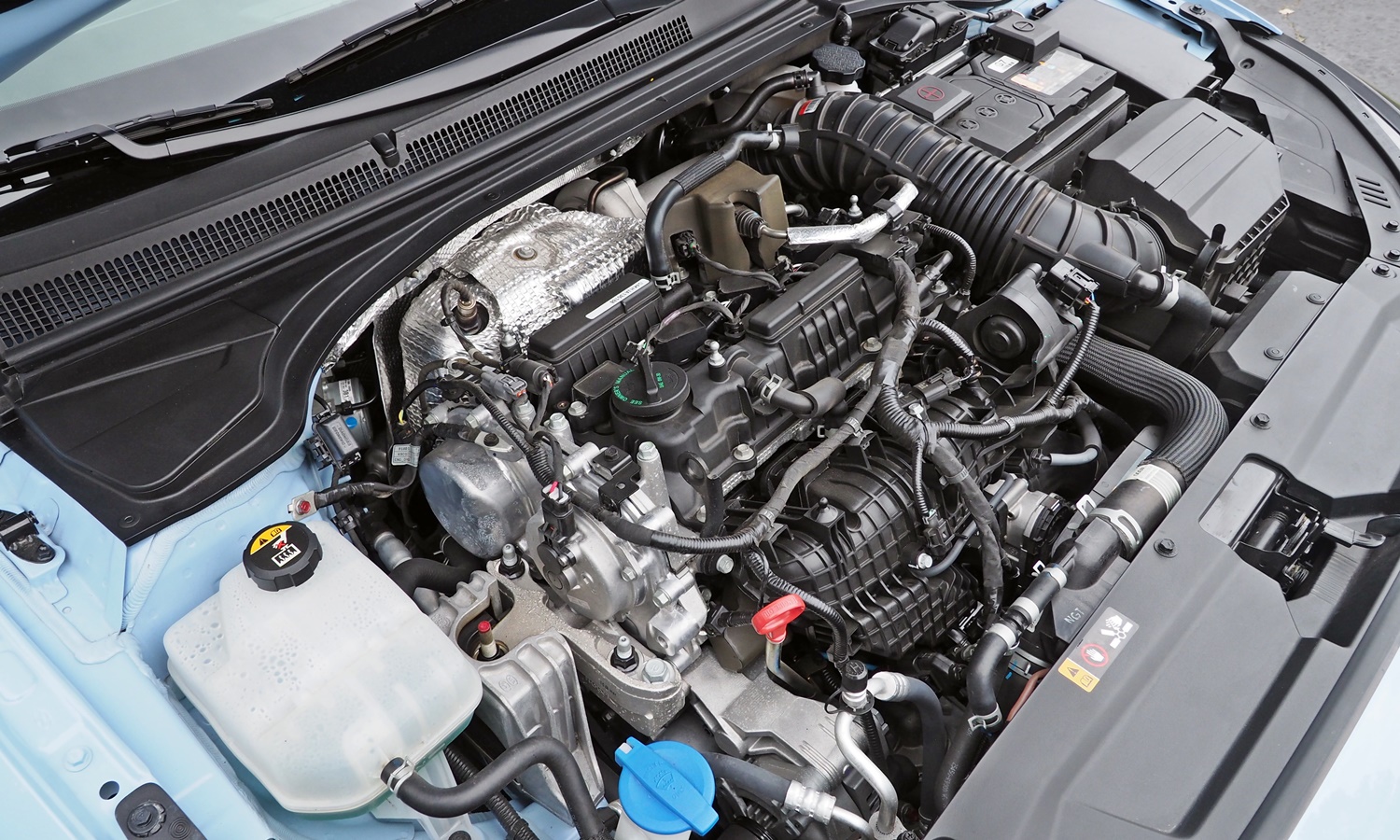
Did you expect 275 horsepower to look more special?
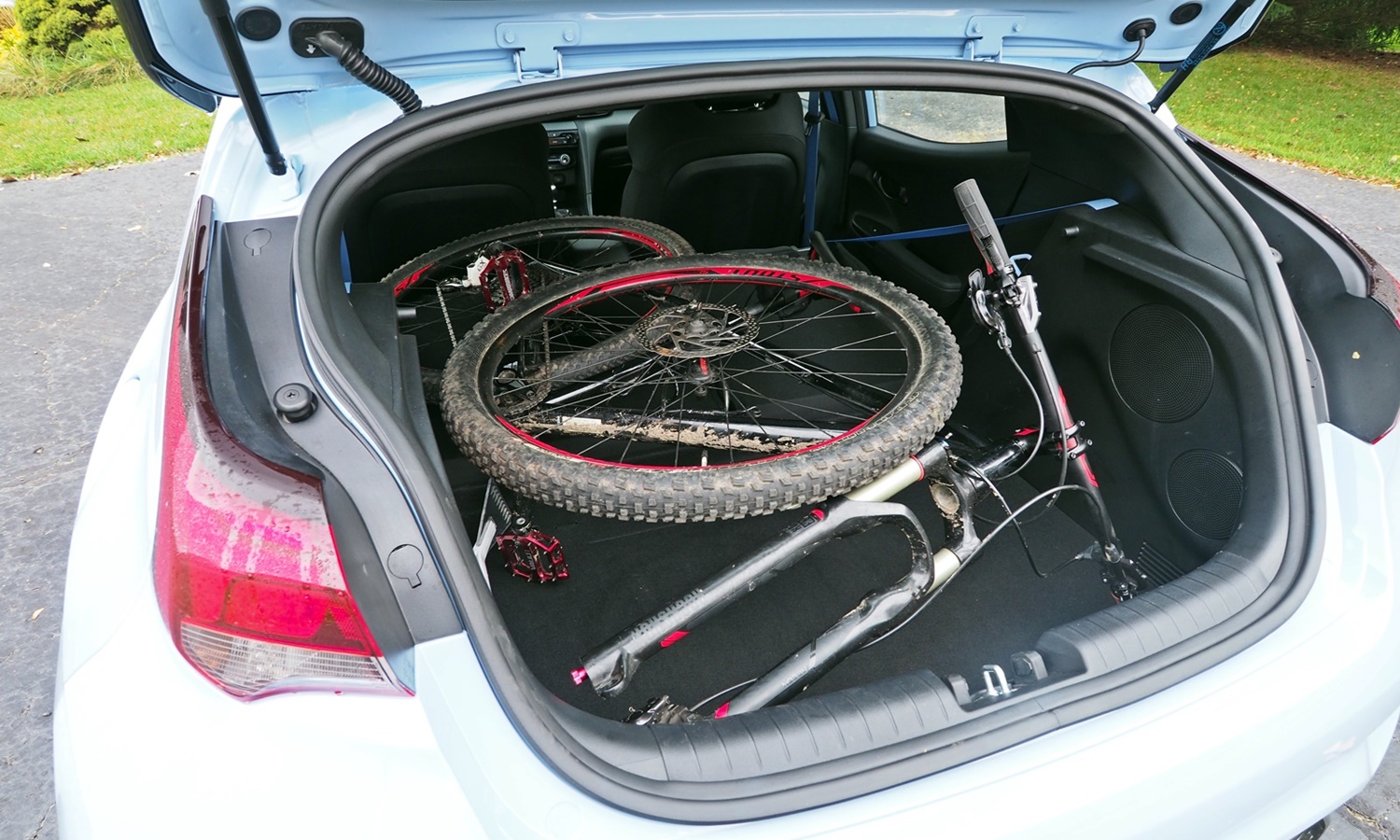
Fold the seats and a 29er mountain bike will barely fit.
See more 2019 Hyundai Veloster photos
Hyundai provided an insured car for a week with a tank of gas. Dan Kelley of Suburban Porsche in Farmington Hills, MI, provided a Jetta GLI for comparison purposes. Dan can be reached at 248-741-7903











